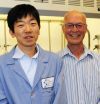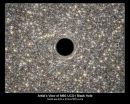(Press-News.org) LA JOLLA, CA—September 17, 2014—Scientists at The Scripps Research Institute (TSRI) have devised a new antibiotic based on vancomycin that is powerfully effective against vancomycin-resistant strains of MRSA and other disease-causing bacteria.
The new vancomycin analog appears to have not one but two distinct mechanisms of anti-microbial action, against which bacteria probably cannot evolve resistance quickly.
"This is the prototype of analogues that once introduced will still be in clinical use a generation or maybe even two generations from now," said Dale L. Boger, the Richard and Alice Cramer Professor of Chemistry at TSRI.
The report by Boger and members of his laboratory was published recently online ahead of print by the Journal of the American Chemical Society.
Increasing Reports of Resistance
Vancomycin entered clinical use in 1958, five years after its isolation from microbes in a soil sample gathered by an American missionary in Borneo. For nearly six decades it has been useful against a wide range of bacteria, and it remains a standard weapon against methicillin-resistant Staphylococcus aureus (MRSA), a major cause of hospital-acquired infections. A compound closely related to vancomycin also has been widely used to protect livestock.
Since the late 1980s, there have been increasing reports of vancomycin resistance in classes of bacteria that usually succumb to the antibiotic, including MRSA. Although vancomycin remains useful, scientists have been looking for new drugs to replace it in cases—often life-threatening—where it no longer can help patients.
The Boger laboratory has focused on inventing improved versions of vancomycin rather than entirely new compounds. "Vancomycin has lasted in clinical use for more than 50 years, in part because it isn't very vulnerable to antibiotic resistance," Boger said. "Our thought has been that if we find a vancomycin analog that addresses this current source of resistance we'll get another 50 years of use out of it."
Vancomycin works by binding to the building blocks of bacterial cell walls, in a way that prevents their proper assembly and leaves bacteria too leaky to live and replicate. The resistance comes from a single amino-acid alteration that some bacteria make to those building blocks, so that the antibiotic molecule can no longer get a firm grip. That drops vancomycin's potency by a factor of about 1,000.
'Incredibly Potent'
In 2012, Boger and his team reported making a vancomycin analog—informally termed vancomycin amidine—with a subtly altered binding pocket that fastens about equally well to the original and resistant sites on bacterial cell wall subunits. To get the precise structural modification they needed, they had to come up with a method for the "total synthesis" of this vancomycin-based compound—a controlled, step-by-step construction using organic chemistry reactions in the lab, rather than a natural enzyme-mediated production within cells.
"Years of work in this lab culminated in a total synthesis strategy that not only allowed us access to this target compound, but also gave us the ability to perform almost any other chemical modification of vancomycin that we wished," said Akinori Okano, first author of the new report, who is an assistant professor of chemistry at TSRI.
Vancomycin amidine turned out to have acceptable level of activity against vancomycin-resistant and -sensitive bacteria, yet there was room for improvement. Thus in the new study, Okano, Boger and their colleagues used their vancomycin synthesis methods to add an additional feature to the molecule—a peripheral chlorobiphenyl (CBP), long known as a general booster of vancomycin's potency.
"To our delight, the combination of these modifications led to an incredibly potent molecule, well beyond anything we had expected," said Okano.
In lab dish tests, the new vancomycin analog proved highly effective against the usual vancomycin-sensitive bacteria as well as vancomycin-resistant MRSA and enterococcal bacteria.
The tests also suggested that the CBP modification, whose boost to potency has been thought to come from some broad enhancement of vancomycin's activity, might in fact work via its own distinct attack on bacterial cell wall synthesis.
"This is probably the clearest depiction to date of the fact that for the CBP derivatives there must be a second mechanism of action, independent of vancomycin's main mechanism of action," Boger said. "[Such analogs] are likely to display especially durable antibiotic activity—that is, they won't be prone to rapidly acquired clinical resistance."
Boger and his colleagues now will try to optimize the synthesis process for the new analog, to provide quantities suitable for preclinical testing in animals.
INFORMATION:
Other co-authors of the paper, "Total Synthesis of [Ψ[C(=NH)NH]Tpg4] Vancomycin and its (4-Chlorobiphenyl) methyl Derivative: Impact of Peripheral Modifications on Vancomycin Analogs Redesigned for Dual D-Ala-D-Ala and D-Ala-D-Lac Binding," were Atsushi Nakayama and Alex Schammel of the Boger Laboratory. For more information, see http://pubs.acs.org/doi/abs/10.1021/ja507009a?journalCode=jacsat
The research was supported by the National Institutes of Health (grant CA041101).
About The Scripps Research Institute
The Scripps Research Institute (TSRI) is one of the world's largest independent, not-for-profit organizations focusing on research in the biomedical sciences. TSRI is internationally recognized for its contributions to science and health, including its role in laying the foundation for new treatments for cancer, rheumatoid arthritis, hemophilia, and other diseases. An institution that evolved from the Scripps Metabolic Clinic founded by philanthropist Ellen Browning Scripps in 1924, the institute now employs about 3,000 people on its campuses in La Jolla, CA, and Jupiter, FL, where its renowned scientists—including three Nobel laureates—work toward their next discoveries. The institute's graduate program, which awards PhD degrees in biology and chemistry, ranks among the top ten of its kind in the nation. For more information, see http://www.scripps.edu.
Scripps Research Institute chemists modify antibiotic to vanquish resistant bacteria
2014-09-17
ELSE PRESS RELEASES FROM THIS DATE:
Habitual Facebook users more likely to be caught in phishing scams
2014-09-17
Washington, DC (September 17, 2014) – Receiving an email that claims you are the recipient of a large sum of money from an unknown deceased relative immediately raises a red flag. These email scams are often trashed or filtered through spam folders. But what about on social networks where there is no filter? Where people can learn about your personal life with a few clicks? A recent study published in the Journal of Computer-Mediated Communication by a researcher at the University at Buffalo – State University of New York found that people who habitually use Facebook were ...
Failed Medicare payments law remains relevant
2014-09-17
PROVIDENCE, R.I. [Brown University] — As Congress adjourns this month for the November elections, one of the killed bills senators will step over on their way out the chamber door will be the Sustainable Growth Rate (SGR) Repeal and Medicare Provider Payment Modernization Act of 2014. In a new commentary in the journal JAMA Surgery, Dr. Eli Adashi recounts what he and other advocates saw as the merits of the originally bipartisan bill. The perennial trouble with how Medicare pays doctors will return for the next Congress, Adashi said, and broader trends in health care practice ...
A massive black hole has been found at the center of an ultra-compact galaxy
2014-09-17
A team of researchers, including an astronomer from Michigan State University, has discovered a huge black hole at the center of an ultra-compact galaxy – the smallest galaxy known to contain one.
The galaxy, known as M60-UCD1, was discovered last year by a team led by Jay Strader, MSU assistant professor of physics and astronomy. Strader was a member of the team that found the black hole.
The findings are detailed in the recent edition of the journal Nature.
The finding suggests that other ultra-compact galaxies also may contain massive black holes. And that those ...
New non-invasive technique could revolutionize the imaging of metastatic cancer
2014-09-17
Bioluminescence, nanoparticles, gene manipulation – these sound like the ideas of a science fiction writer, but, in fact, they are components of an exciting new approach to imaging local and metastatic tumors. In preclinical animal models of metastatic prostate cancer, scientists at Virginia Commonwealth University Massey Cancer Center, VCU Institute of Molecular Medicine and Johns Hopkins Medical Institutions have provided proof-of-principle of a new molecular imaging approach that could revolutionize doctors' ability to see tumors that have metastasized to other sites ...
Hubble helps find smallest known galaxy containing a supermassive black hole
2014-09-17
Astronomers using data from NASA's Hubble Space Telescope and ground observation have found an unlikely object in an improbable place -- a monster black hole lurking inside one of the tiniest galaxies ever known.
The black hole is five times the mass of the one at the center of our Milky Way galaxy. It is inside one of the densest galaxies known to date -- the M60-UCD1 dwarf galaxy that crams 140 million stars within a diameter of about 300 light-years, which is only 1/500th of our galaxy's diameter.
If you lived inside this dwarf galaxy, the night sky would dazzle ...
Space: The final frontier… open to the public
2014-09-17
Historically, spaceflight has been reserved for the very healthy. Astronauts are selected for their ability to meet the highest physical and psychological standards to prepare them for any unknown challenges. However, with the advent of commercial spaceflight, average people can now fly for enjoyment. The aerospace medicine community has had very little information about what medical conditions or diseases should be considered particularly risky in the spaceflight environment, as most medical conditions have never been studied for risk in space — until now.
The aerospace ...
NASA releases IRIS footage of X-class flare
2014-09-17
On Sept. 10, 2014, NASA's newest solar observatory, the Interface Region Imaging Spectrograph, or IRIS, mission joined other telescopes to witness an X-class flare – an example of one of the strongest solar flares -- on the sun. Combing observations from more than one telescope helps create a much more complete picture of such events on our closest star. Watch the movie to see how the flare appears different through the eyes of IRIS than it does through NASA's Solar Dynamics Observatory.
The movie shows IRIS imagery focused in on material at around 60,000 Kelvin (107,500 ...
Power isn't enough: Study reveals the missing link for effective leadership
2014-09-17
NEW YORK—With the National Football League in full damage-control mode, there are many questions about how the NFL's leader handled the Ray Rice case. Was Goodell ignoring the pleas of stakeholders—former NFL players, the media and domestic violence groups—when deciding on a two game penalty? The answer may lie in a study out today by Columbia Business School.
The research, just published in Social Psychological and Personality Science, finds that leaders who fail to take into account their audiences' perspective have a far greater propensity to bungle the issue and conversation. ...
Reducing traffic congestion with wireless system
2014-09-17
At the Intelligent Transportation Systems World Congress last week, MIT researchers received one of the best-paper awards for a new system, dubbed RoadRunner, that uses GPS-style turn-by-turn directions to route drivers around congested roadways.
In simulations using data supplied by Singapore's Land Transit Authority, the researchers compared their system to one currently in use in Singapore, which charges drivers with dashboard-mounted transponders a toll for entering congested areas.
The Singapore system gauges drivers' locations with radio transmitters mounted on ...
NASA sees Odile soaking Mexico and southwestern US
2014-09-17
Tropical Storm Odile continues to spread moisture and generate strong thunderstorms with heavy rainfall over northern Mexico's mainland and the Baja California as well as the southwestern U.S. NASA's Tropical Rainfall Measuring Mission or TRMM satellite measured rainfall rates from space as it passed over Odile.
Odile had weakened to a tropical storm with winds of about 55 knots (63.3 mph) when the TRMM satellite flew over on September 16, 2014 at 0917 UTC (2:19 a.m. PDT). Odile was still well organized and TRMM's Precipitation Radar (PR) measured rain falling at a rate ...



